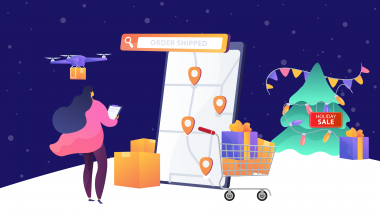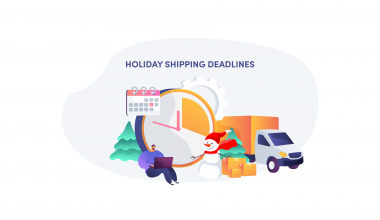The holiday season arrives, and the shipping floodgates that were once holding back the tide finally open. Chaos becomes the new norm, especially when everyone expects their shipments to be delivered on time. Some are looking for fresh cooking materials for dinner parties, while others eagerly await their presents to arrive. Timely shipping and intact products are not just expectations but necessities.
If shipping were smooth to begin with, there would be no reason for this guide. The recent postal strikes have already threatened the market, and many are preparing to be disappointed. When these issues combine with the need to manage high volumes, hundreds of thousands of packages, and the fact that Canadian snow spares no one, “delay” tends to become a constant companion.
But not all hope is lost. Some shipping companies have been able to tackle these problems. Snow does not bother them, postal strikes cannot slow them down, and they have cleverly curtailed the challenges related to high volumes in style. These top 5 brands are winning Canada’s holiday rush, and there is much to learn from them.
Why the Holiday Season Is a Logistics Minefield for D2C Brands?
With holidays come cheer, but that cheer is often dependent on material things like presents, food, and other goods, which turns the holiday season into a logistics minefield for D2C brands.
Surge in Order Volume
Holidays are for everyone, and everyone wants to celebrate in a big way, which means order volumes increase not by one or two times but exponentially. Black Friday sales attract massive crowds, and Cyber Monday makes tech goodies more appealing. The gift rush that follows often causes many customers to appear out of the woodwork, which, for D2C brands, can be a nightmare if not handled properly.
High Customer Expectations
What do customers want? Their products are on time and unspoiled. What do they not want under any circumstances? Delays. The expectation of perfection is not just paramount but is the principle that can make or break a D2C brand. Delay one item or handle even a small flower without proper care, and the customer will turn away and start looking elsewhere.
There is no wiggle room during the holiday season. Things have to be done fast, and they have to be done right, all the time.
Layer of Unpredictability
For the last couple of years, Canada Post employees have expressed their dissatisfaction with pay and working conditions and the fact that they are expected to do more than they are capable of. While the latest news is that Canadian postal workers will begin rotating their strike periods, the damage is already done, and delays are becoming expected.
Cross-border strikes also add another layer of unpredictability, burdening companies with additional paperwork and aggravating the annoyance and the delay.
Financial & Reputational risks for delays and missed delivery
One dreams of having an understanding customer, one who comprehends the effort companies go through when delivering, but it remains a dream. A single delay can make the customer look elsewhere. While losing a “customer in-the-moment” is common, especially if the customer is desperate, it is the reputational risk that must be feared. Repeated delays begin to remove stars from online and offline reviews, often pushing D2C brands dangerously close to bankruptcy.
Canadian Brands That Nail Holiday Shipping
While the minefield of challenges is vast, some Canadian brands have already gotten ahead of the curve. They have realized what they must do to keep their businesses moving, which has led to an increase in their reputation.
1. Pressure King Pro :Real-Time Rerouting During the Canada Post Strike
When the Canada Post strike hit during the peak shopping season, Pressure King Pro refused to let shipping chaos spoil its momentum. Instead of waiting it out, the company strategized, quickly shifting gears and partnering with regional couriers to keep orders moving.
Customers were kept in the loop at every step. They received real-time updates, honest timelines, and proactive information. This turned what could have been a PR nightmare into a demonstration of reliability. As a result, the company curtailed mass delivery delays and preserved buyer confidence during one of the toughest shipping periods on record.
Takeaway: Backup carriers and transparent communication are a brand’s best defense against last-mile uncertainty
2. YYC Beeswax : The Small Brand with a Big Backup Plan
Calgary-based YYC Beeswax was not an unknown player when dealing with Canada Post’s disruption. It had faced the issue before and lost revenue. But that loss became a lesson, and the brand decided never to rely on a single delivery channel again. By partnering with multiple carriers and offering full visibility on its website, YYC Beeswax built a shipping model that kept customers reassured even when larger networks faltered.
Its collaboration with local delivery services also meant faster regional drop-offs, lower costs, and stronger community ties. When delays hit national networks, YYC Beeswax barely flinched.
Takeaway: Local and multi-carrier approaches can shield small businesses from national shipping bottlenecks.
3. Canadian Tire : Omnichannel Fulfillment on Overdrive
Canadian Tire focused its efforts on increasing its omnichannel strength while smaller brands scrambled to survive the holiday season. For this company, every store became a mini fulfillment hub that dynamically routed online orders to the nearest location instead of overloading central warehouses.
It relied on advanced order-management technology to balance demand and offered same-day pickup and express delivery to keep holiday shoppers satisfied. This agile, data-driven setup transformed retail floor space into a logistics advantage, proving that scale can mean speed when systems are connected.
Takeaway: A well-integrated store network isn’t just a sales channel but could be leveraged as a fulfillment powerhouse during seasonal peaks.
Industry Trends: What Winning D2C Brands Have in Common
Canada’s holiday retail scene has made one thing is clear: shoppers crave speed, certainty, and communication. People expect free shipping not as a perk, but as a “given”, and brands that combine it with real-time tracking and proactive updates to provide complete transparency to their customers. Recent retail surveys suggest that over 80% of shoppers now expect live order tracking, and many are quick to abandon carts or switch retailers at the first sign of delivery uncertainty.
To keep up, more D2C businesses are building local carrier partnerships to shorten last-mile routes and reduce risk during national disruptions. Companies aren’t focused on price wars anymore; it is delivery performance that matters much more.
Takeaway: Winning brands treat logistics like customer service: clear, fast, and consistently dependable.
What These Brands Teach Us About Holiday Survival
If this year’s peak season has proven anything, it’s that success depends on preparation, not luck. The brands that have been able to only survive, but thrive, through Canada’s busiest shopping weeks all shared a few critical traits: diverse carriers, redundant fulfillment options, and unrelenting communication.
Carrier diversification ensured that one system’s breakdown didn’t stop the delivery ball rolling. Fulfillment redundancy thanks to using stores, local hubs, or multiple warehouses kept inventory flowing when national networks slowed. And open, frequent updates built customer patience rather than frustration.
Local courier agility also emerged as a secret arsenal in leading brands’ quiver. While major networks faced delays, small regional partners became the heroes of last-mile delivery. With labor strikes and peak demand overlapping, these nimble setups offered the resilience big players often struggle to match.
Your Holiday Shipping Action Plan: Inspired by the Best
- Audit your shipping partners: Review each carrier’s past performance and reliability before peak season hits.
- Add backups for every region: Secure at least one alternate courier in every key delivery zone to avoid bottlenecks.
- Communicate deadlines early: Publish cut-off dates clearly to inform customers about when to order for guaranteed delivery.
- Prep CS scripts for delays: Equip your support team with ready responses and tone guidelines for handling shipment hiccups.
- Train your team for rerouting workflows: Run mock drills to ensure staff can quickly switch carriers or fulfillment nodes if disruptions occur.
Ready to Build Your Holiday Shipping Game Plan?
Peak season success starts long before the first parcel ships. The right logistics strategy can mean the difference between delighted repeat buyers and carts lost to delivery anxiety. Whether it’s refining carrier networks, setting clearer communication flows, or tightening fulfillment timelines, preparation is everything.
Talk to ShippingChimp’s experts to map your tailored plan today.
FAQ:
What’s the biggest shipping challenge during Canada’s holiday season?
Capacity crunch and weather delays often collide, overwhelming major carriers and extending delivery times.
What are good alternatives to Canada Post during disruptions?
Consider regional couriers like Purolator, Canpar, ShipBob, or local same-day networks for faster rerouting.
How soon should I plan for holiday shipping?
Start at least two months ahead: secure carriers, stock warehouses, and publish cut-off dates early.
How can I manage customer expectations around delays?
Communicate transparently with real-time tracking, proactive updates, and honest delivery estimates.
What should I do if my orders are stuck due to a strike?
Alert customers immediately, shift new orders to alternate couriers, and offer flexible refund or pickup options.
- The Last Minute Customer Strategy: Handling Orders After the Carrier Cut-off - December 12, 2025
- Holiday Shipping Deadlines 2025: When to Ship for On-Time Christmas Delivery - December 3, 2025
- Best Shipping Software for Canadian D2C Brands - November 25, 2025






